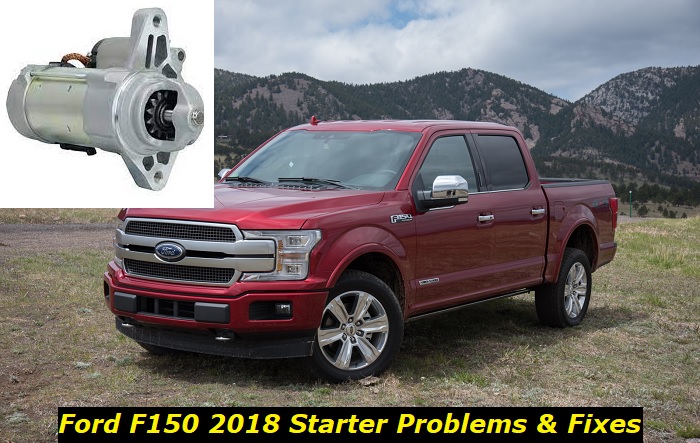In this article, we will help you diagnose the most common causes of starter problems in the 2018 F150 and consequently aid you in finding their cure.
No-start problems highlights
- DIY repairs:possible but complicated
- Tools needed:basictools set
- Commonreasons:battery issues, wiring problems, bad connections, electronic unit failure
- Time to repair:0.5 - 3 hours
- Price for parts:$100 - $450
- Can you drive?Obviously, no
- Alternative solutions:jump-starting, starter shorting, tow-truck

So, without further ado, here are the most usual suspects that are contributing to the underlying problem in this particular product:
1. Weak or Corroded Battery
Weak or corroded batteries are among the most common causes of starter problems in the 2018 Ford F150. The battery is an integral part of the engine cranking system and its failure can lead to several issues with starting the vehicle.
When a weak or corroded battery is present, it may not have enough power to fully engage the starter motor, resulting in a "chattering" sound as the starter tries but fails to turn over the engine. Additionally, if there is extensive corrosion on the battery terminals, this can prevent electricity from reaching other parts of the car such as ignition coils and spark plugs that are required for normal engine operation.
The best way to diagnose a weak or corroded battery issue is by looking at visual signs of wear and corrosion on the battery's terminals or cables. A multimeter can be used to check the battery's current output to determine whether it is below the normal operating voltage range as well. If either of these tests reveals an issue with the battery then the next step is to clean off any corrosion from its terminals and check the charge level of the battery.
If cleaning fails to resolve the weak or corroded battery issue then it may need to be replaced altogether. A new battery should have enough power to engage the starter motor and other components required for normal engine operation. It is important to make sure that all connections are properly tightened before attempting to start the vehicle as loose connections can prevent electricity from reaching critical components like the starter motor.
Once a new battery has been installed, check the voltage and terminal connections to ensure that they are in good condition before attempting to start the engine.
Finally, if there is a larger electrical fault present, it should be dealt with separately as fixing this problem may be more complex than simply replacing or cleaning the battery terminals. In these cases, a qualified mechanic who can diagnose and repair the underlying issue should be consulted. With proper maintenance and regular inspections of the battery, most weak or corroded battery issues can easily be avoided and save drivers from having to deal with costly repairs down the road.
2. Key Fob Battery is Drained
Sometimes, the issue can be as simple as your key fob running out of battery power. To confirm this, try to remember how long has its battery been running, and if it's already between three to four years, it likely needs to be replaced. Other indicators include corrosion on the battery and its terminals or if the reading from your multimeter reads under 2 volts.
Simply replace the battery should you see the said signs and ensure that the key fob is sealed properly when you're done.
3. Blown Fuse
A blown fuse might also be the cause of your starter problems. This is more likely to happen when high-powered accessories are plugged in for extended periods, such as stereos and aftermarket amplifiers.
To check for a blown fuse, locate the main power fuse box located under the driver's side dashboard. Then, open the fuse box and check for any blown or corroded fuses that might be preventing power from reaching the starter. If any fuse appears damaged or corroded, replace it with a new one of the same amperage and try starting the engine again.
If the car still won't start, then the fuse box itself may be damaged and in need of repair or replacement. In this event, a qualified mechanic should be consulted to diagnose and repair the underlying issue.
4. Starter Motor Failure
The life expectancy of the F150's starter motor is around 100,000 to 150,000 miles before requiring a replacement. There may be instances where this can be shortened due to other factors. If the starter motor fails, it can cause several problems such as a no-start condition or an engine that cranks but does not start.
To find the source of this problem, there are several steps one must take. First, look for any visible damage to the starter motor. If all looks normal, move on to assessing the battery and its related components such as cables and terminals.
Checking these items should be done with a voltage meter. If readings from the device are low or nonexistent in certain areas, then this could be causing issues with the starting system. Lastly, check for any blown fuses or open relays associated with the starter circuit before moving on to removing and testing the starter itself.
If all of these checks do not reveal any cause for concern, the starting system itself may have a fault. In this case, it would be advised to either take the vehicle to a trusted mechanic or dealership for further diagnosis if you cannot perform the repair yourself.
Those who are more mechanically inclined and have some experience with automotive repairs should be able to replace the starter motor and its related components with relative ease. It is important to note that if any of the parts are not installed properly it could result in further starting issues. As such, it would be wise to have a qualified professional check the work before using the vehicle again.
By following these steps, one should be able to accurately diagnose and repair any problems with the 2018 Ford F150's starter motor that may arise. Doing this will help ensure continued reliable performance from the vehicle for many miles down the road.
5. Damaged Alternator
Normally, the alternator of your F150 should last over the maximum lifetime of the truck, which is somewhere between 200,000 to 300,000 miles. However, certain conditions can reduce the lifespan of the alternator, such as overloading it with additional electrical components or wires.
In certain instances, a damaged alternator can prevent the truck from starting, as it is responsible for providing electrical power to all of its components. To test for a faulty alternator, one should first check to see if the battery gauge is reading abnormally low or not at all.
This can be done either through the vehicle's instrument cluster or with a voltmeter. If this is the case, then it is likely that the alternator is not providing enough power to all the necessary systems.
Next, one should check for any visible signs of damage to the alternator itself. If everything appears normal, then it is necessary to check the alternator's output. This can be accomplished by testing the voltage at its terminals or with a multimeter. If the output is lower than it should be, then it is likely that the alternator has failed and needs to be replaced.
After that, if the alternator is not generating any voltage at all or if the battery light remains illuminated even after the new part is installed, then the issue may be with a related component such as its wiring harness or regulator. These should be checked, too, in order to ensure that they are working properly before attempting to start the truck again.
6. Worn Spark Plugs
When the spark plugs of a 2018 Ford F150 become worn over time, they can cause several issues with starting and running the truck. This is because the spark plug is what ignites the fuel/air mixture inside each cylinder of the engine, and if it cannot generate enough spark then the engine will not start or run correctly.
To detect a worn spark plug, start by inspecting them for any visible damage such as cracks, breaks, or heavy deposits on its tips. If any of these symptoms are present, then it is likely that at least one of the plugs has failed and needs to be replaced. It would also be wise to replace all of them at once to ensure uniform performance from all cylinders.
Moreover, one should check for any abnormal readings on the spark plug's electrodes. This can be done with a multimeter or even by removing them and examining them under a powerful lens for major wear. If any of the readings are significantly lower than what they should be, then it is likely that the spark plugs are not providing enough power to ignite the fuel/air mixture and need to be changed.
7. Faulty Fuel Pump
The fuel pump of the 2018 Ford F150 is responsible for sending fuel from the tank to the engine, and if it fails then it can cause significant starting issues. To test for a faulty fuel pump, you should first check to see if there is any visible damage to its wires or its housing unit.
Furthermore, you should also inspect the vehicle's fuel filter to make sure that it is not clogged or blocked in any way. Finally, use a multimeter or voltmeter to test the voltage coming from the pump itself. If no voltage is present at all or if it reads significantly lower than what it should be (which can generally vary between 12-14 volts), then it is likely that the fuel pump has failed and should be replaced.
Conclusion
There are many potential causes for starting issues in a 2018 Ford F150, including the ones mentioned here and more. By taking the time to inspect these components individually, one can quickly diagnose the issue and take appropriate action to make sure their truck is up and running again in no time.
Furthermore, proper maintenance of your 2018 Ford F150 is essential for keeping it functioning optimally. Regular inspections of key components such as the ones shown here and other related parts will help identify any wear or damage early on so that proper repairs can be made before the vehicle becomes undrivable.
Taking the time to check these parts periodically and fixing them accordingly if you see problems is an investment that will help ensure the safe and reliable operation of your truck.
About the authors
The CarAraC research team is composed of seasoned auto mechanics and automotive industry professionals, including individuals with advanced degrees and certifications in their field. Our team members boast prestigious credentials, reflecting their extensive knowledge and skills. These qualifications include: IMI: Institute of the Motor Industry, ASE-Certified Master Automobile Technicians; Coventry University, Graduate of MA in Automotive Journalism; Politecnico di Torino, Italy, MS Automotive Engineering; Ss. Cyril and Methodius University in Skopje, Mechanical University in Skopje; TOC Automotive College; DHA Suffa University, Department of Mechanical Engineering






Add comment